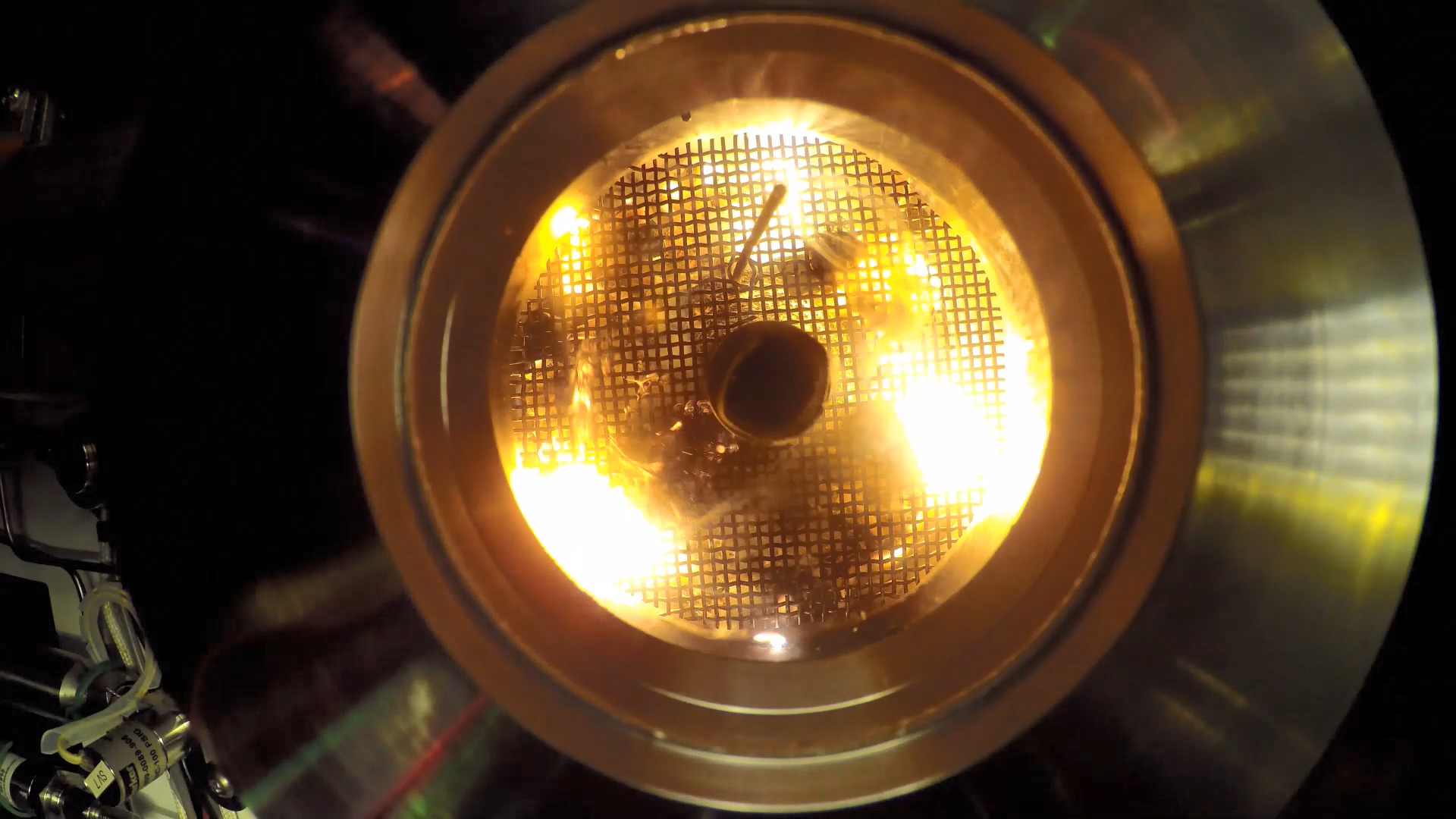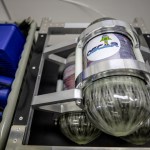OSCAR
Orbital Syngas/Commodity Augmentation Reactor

OSCAR is a test rig designed to convert solid trash to gas. Researchers at NASA’s Kennedy Space Center in Florida are using OSCAR to test the feasibility of the “trash-to-gas” concept in microgravity. OSCAR uses thermal processes to convert trash into a mixture of gases called synthetic gas or syngas – an assortment of gases including carbon dioxide, carbon monoxide, water vapor, and methane, among others. Astronauts could potentially use these gases as supplies or vent them from the spacecraft during a mission to reduce the mass of the spacecraft. OSCAR and “trash-to-gas” is one of several potential solutions NASA is investigating to reduce, reuse, and recycle waste generated by astronauts for future missions as part of its logistics reduction and resource reutilization strategy.
The research team had to design OSCAR to survive the rigors of testing and launching into space, all while running the experiment and collecting data without any direct human intervention while it was in microgravity.
Trash in Space
Where people go, trash follows. This includes people living and working in space. Trash generated in space includes logistical trash like food packaging, clothing, hygiene items, uneaten food, expendable maintenance items, and other waste. Currently on the International Space Station, the crew stores their trash aboard the orbital lab until they can load it into a departing spacecraft. The trash goes in one of the different types of expendable vehicles that regularly supply the station. These spacecraft, like the Cygnus and Progress, burn up upon reentry into the atmosphere, disposing of the trash via incineration.
Astronaut-generated waste presents several problems for humans aboard a spacecraft. In one year, a crew of four can generate approximately 5,700 pounds (2,600 kilograms) of trash that astronauts must store on the spacecraft. Finding better ways to deal with trash can reduce the total mass launched into space, maximize usable living space on the ship, and make in-flight maneuvers more efficient by reducing mass after launch. Effectively dealing with trash can also improve the comfort and safety of the crew by reducing problems like bad smells associated with trash and potential hazards – both health hazards from biological material in the waste and physical hazards from discarded materials.
How OSCAR Works
Currently, OSCAR combines oxygen, heat, and trash in a reactor. The reactor ignites the trash, circulating the mixture in a swirling motion as the waste transitions into a gas. OSCAR collects and condenses gases created in the reactor for storage and later analysis by the team. Other combustion products like ash and water also stay in the system so the team can study them as well.
OSCAR is an automated system, capable of running through all its flight procedures without human intervention. The OSCAR team hopes these tests will determine the most effective thermal process to convert trash into gas. They have tested steam reforming, incineration, and pyrolysis, as well as gasification. For these initial tests, OSCAR used a laboratory-created simulant that approximates the waste products generated by astronauts.
OSCAR and Microgravity
Decades of space exploration have demonstrated that many physical processes operate differently in the absence of gravity. Combustion and convection behave differently in microgravity compared to on Earth. However, creating microgravity conditions on Earth is difficult. To achieve just over five seconds of microgravity in the Zero Gravity Facility at NASA’s Glenn Research Center in Ohio requires dropping experiments 432 feet (132 meters) and then safely bringing them to a stop without damaging the payload. These few seconds in microgravity was enough for the team verify that many of their core systems worked. On its first suborbital flight, OSCAR experienced about three minutes of microgravity, successfully turning trash into gas. Using the results of the flight, the team studied the differences between testing with and without gravity.
A Brief History of OSCAR
OSCAR started as an Early Career Initiative (ECI) award in 2018, funded by NASA’s Space Technology Mission Directorate to address a technology gap in reducing the logistics needed to enable deep space, long-duration human spaceflight. NASA uses this initiative to fund small teams to perform work advancing promising new technologies. The projects require working with an external partner to leverage capabilities and expertise outside NASA. The work also serves as professional development for the team members, consisting primarily of early career scientists, engineers, and technologists.
The OSCAR team worked with NASA’s Flight Opportunities program to find a suitable vehicle that met the team’s requirements to mature the technology in the relevant testing environment, which for OSCAR was microgravity. Blue Origin received a flight contract award to fly the rig on a suborbital flight. The team performed design, fabrication, and testing work at Kennedy, then validated OSCAR in brief periods of microgravity using both the 2.2-second Drop Tower and Zero Gravity Facility at Glenn Research Center. The first flight aboard Blue Origin’s New Shepard 12 mission occurred Dec. 11, 2019.
In 2020, OSCAR transitioned from an ECI project to a payload facilitated by funding from the NASA Human Exploration and Operations Mission Directorate’s Advanced Exploration System Logistics Reduction Program. The OSCAR team incorporated lessons learned from their first flight to modify the payload for the second flight. OSCAR is slated for a second suborbital flight aboard Blue Origin’s New Shepard Mission NS-17. The data OSCAR gathers during its return to microgravity will improve models for converting waste into gases, which will inform future logistics reduction work at NASA.
Quick Facts
Co-Principal Investigators: Dr. Annie Meier and Ray Pitts
Suborbital Launch Provider: Blue Origin of Kent, Washington
Thermal Processes Used: Oxygen enriched steam (flight 1); combustion (flight 2)
Gas Products (Primary): Carbon dioxide and numerous other gases
Team Members: A diverse team of NASA and contracted scientists, engineers, and interns dynamically combined a multitude of skills together to make OSCAR a success.
2nd Flight: Gino Carro, Mike Csonka, Emily Forrester, Jonathan Gleeson, Joel Olson, David Rinderknecht, Steven Runyan, Malay Shah, Camiren Stewart, Phil Stroda, Jaime Toro Medina
1st Flight Only Team: Evan Bell, Michael Harris, Jake Hochstadt, Syrus Jeanes, Pri Johnson, Matthew McGuire, Matt Nugent, Joshua Santora
Interns: Nilab Azim, Morgan Benson, Tom Cauvel, Dherby Essumang, Courtney Golman, Mirielle Kruger, Katie Ludden
Drop Tower Testing: In 2018, OSCAR underwent just over 2 seconds of microgravity testing at NASA’s Glenn Research Center and just over 5 seconds of microgravity testing in 2019.
Launch History: OSCAR launched Dec. 11, 2019, aboard Blue Origin’s New Shepard NS-12 mission from Texas and experienced approximately three minutes of microgravity.
Funding Sources: OSCAR started as an Early Career initiative project funded by NASA’s Space Technology Mission Directorate. It has also received funding from NASA’s Human Exploration and Operations Mission Directorate Advanced Exploration Systems Logistics Reduction Program. Funding to perform a second flight came from NASA’s Flight Opportunities with support from the ECI.




























